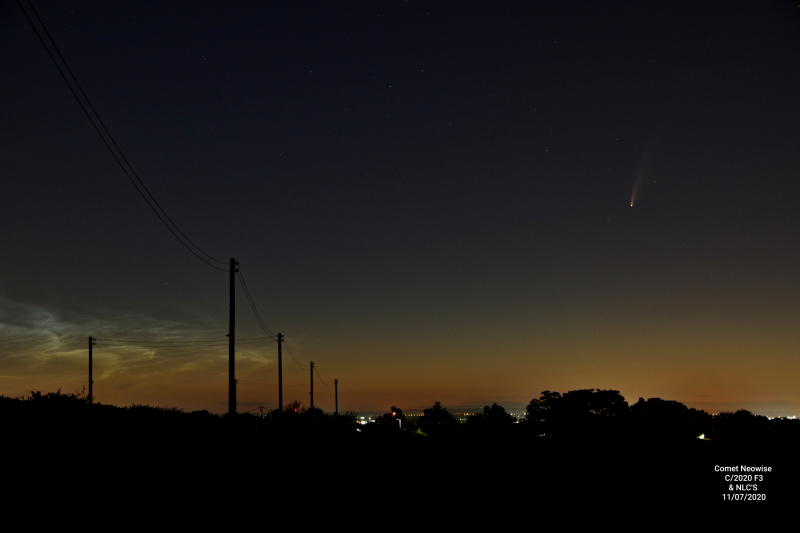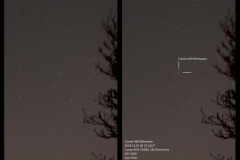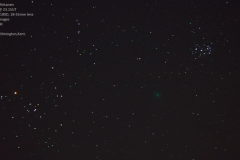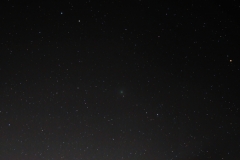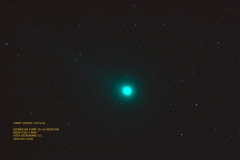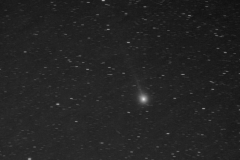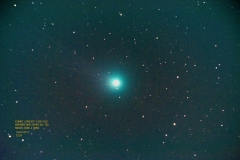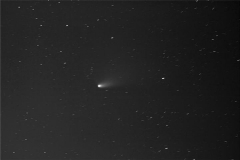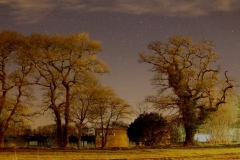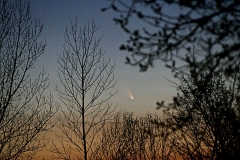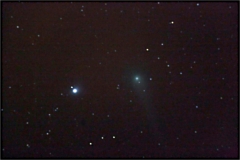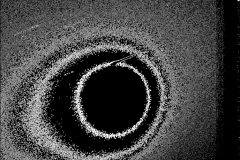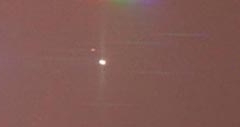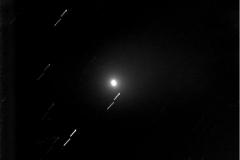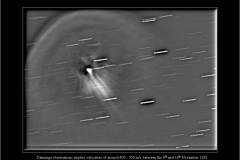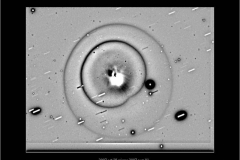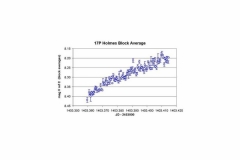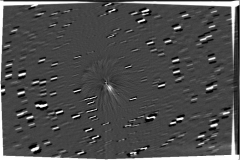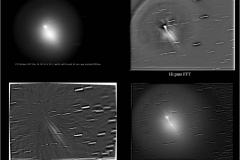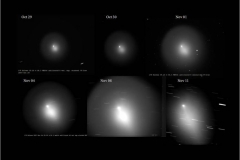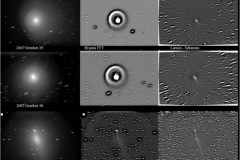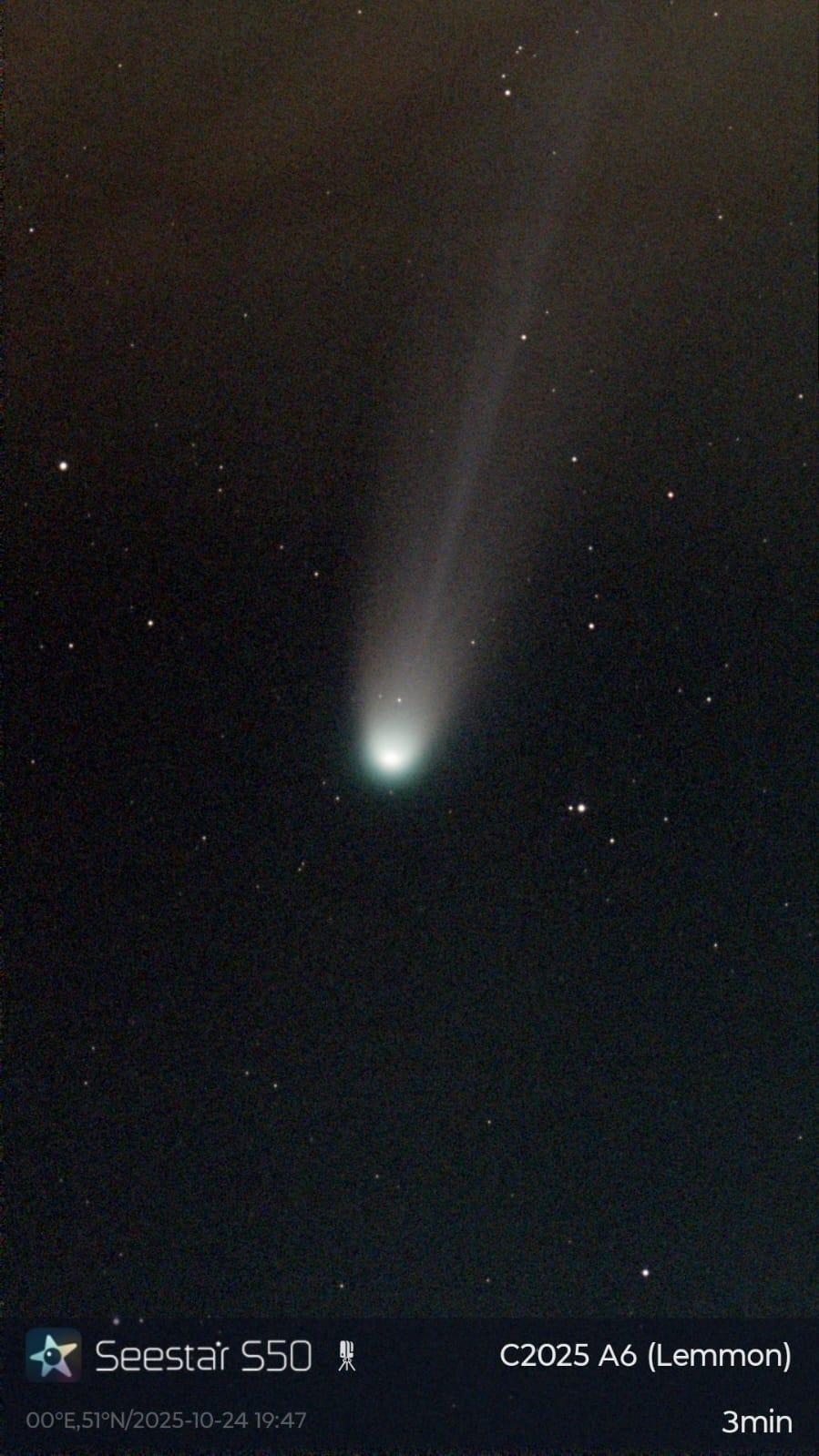Comets are usually named after their discoverer(s) family name, although with science increasingly being the result of large team efforts, the name of the team or project can be more appropriate so is often used.
Comet C/2022 E3 (ZTF) – 27th Jan 2023 by Dr Mike Rushton
A super photo of Comet C/2022 E3 (ZTF) taken on 27th Jan 2023 by Dr Mike Rushton using an eVscope.
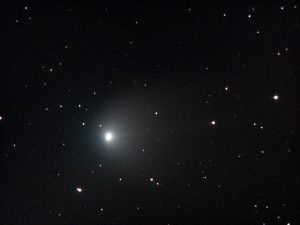
Comet C2022 E3 (ZTF) – 22nd Jan 2023 by Honor Wheeler
CMHASD member Honor has managed to capture Comet C/2022 E3 (ZTF) that is gracing our skies at the moment in a photo back on the 22nd Jan 2023.
Honor said ”I watched Nick James sky notes on today’s BAA meeting about Comet E3 so decided to look for it. Not that easy to find but it is unmistakable as a faint fuzzy in binoculars. So I took a photo just to prove I wasn’t seeing things. Worth a decent image with a telescope with more time than I had.”
The comet is the fuzzy patch centre right in the photo.
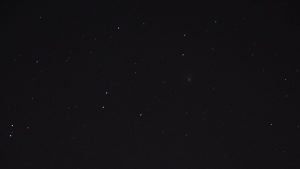
Comet C/2019 L3 (ATLAS) by Simon Dawes
A fantastic image of Comet C/2019 L3 (ATLAS) in Gemini taken by Simon Dawes on the 24th April 2022 from Bexleyheath in Kent.
Simon has included detail about how and when he acquired the image on the photo below showing the comet which is the fuzzy round shape in the centre of the image.
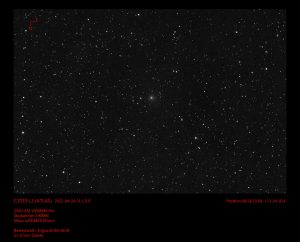
Comet C/2019 L3 (ATLAS) was discovered on the 9th of June 2019 by the ATLAS program.
Comet C/2020 F3 NEOWISE – The Great Comment of 2020
Comet c/2020 F3 Neowise was visible for a couple of weeks in the Northern sky, quite close to the horizon, to say it was spectacular is an understatement and the brightest comet since Hale Bopp visible from the UK.
Images by Simon Dawes
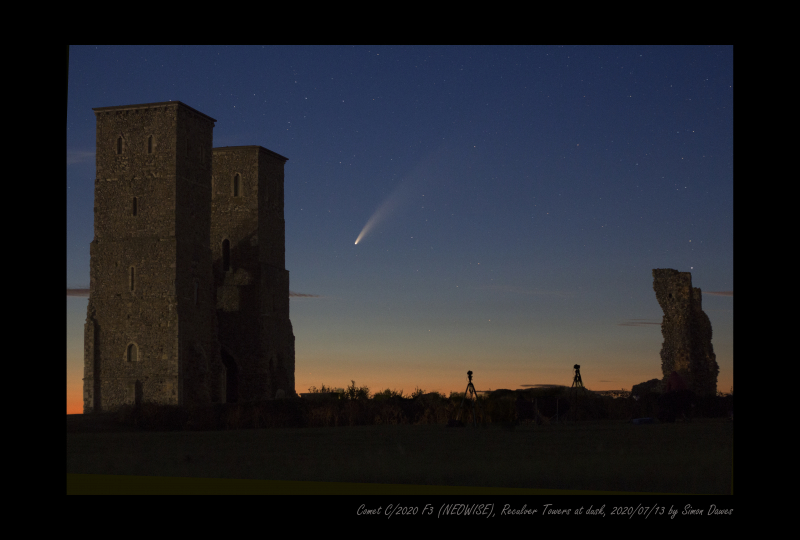
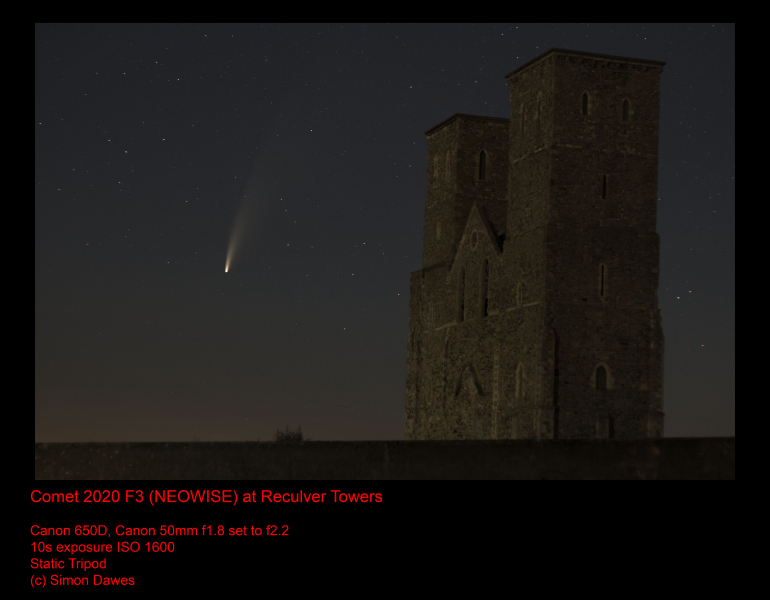
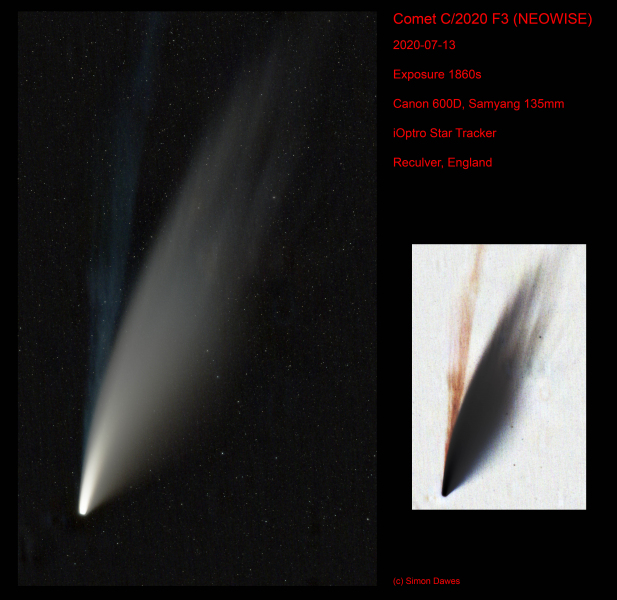
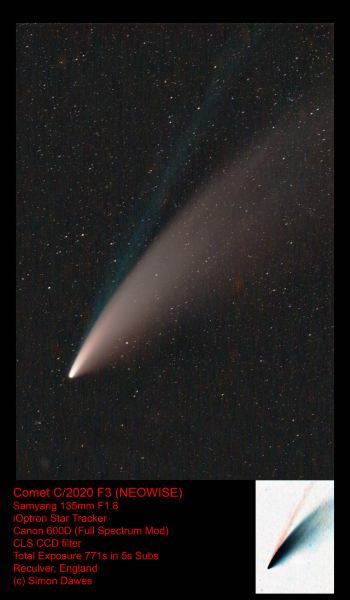
46P Wirtanen
Comet 46P Wirtanen was billed to be brighter than ever this apparition and when at its brightest it would be passing within 1 degree of M45, however the UK weather conspired against us, some members got images from outside the UK and others from before it reached its brightest, but our visit to Ashdown forest was cancelled due to 100% cloud cover and rain.
On Thursday 13th December 2018 many members observed the comet at the Dick Chambers Observatory, through binoculars (a very faint fuzzy blob only visible with averted vision) and through the 16″ Peter Hindle telescope.
Comet Wirtanen, 46P taken 16 Dec. 2018 @ 0030 hrs., in Cottowood, Arizona, USA by Richard Bohner
Canon 6D, 200mm f2.8 lens, ISO 800
75 second exposure time.
Image by Richard Bohner
Here is my latest image of Comet 46P. Taken Thursday night.
Canon 6D, 200mm lens f2.8, ISO 800 60 second exposure.
It was a little windy Thursday night with gusts of 25mph and moon
Image by Richard Bohner, tahen on 8th December 2018 in Cottonwood, Arizona
Comet 46P Wirtanen on 8 Dec with Canon 6D with 200mm f2.8 lens, 60 second exposure.
Image by Honor Wheeler
I’ve been getting some practice with deep sky stacker, not as scary as I thought here is my first attempt using it to stack some images of the comet.
Image by Honor Wheeler
I’ve been lucky to have imaged the comet twice myself, once on Friday 7th & again on Sunday. The seeing has been pretty poor but it was just visible in 10×50 binoculars and looked pretty good in my 72mm refractor and 40mm eyepiece.
C2014/ Q2 Lovejoy
C/2014 Q2 (Lovejoy) is a long-period comet discovered on 17 August 2014 by Terry Lovejoy using an 8″ telescope.
It was discovered at an apparent magnitude of 15 it is the fifth comet discovered by Terry Lovejoy.
This image of Comet Lovejoy was taken by member Gordon Collings on the 24th January 2015 at 20:29 using a SkyWatcher Esprit ED 120, NIkon D300, 4m exposure, using an Astronomik CLS Filter.
Taken on the 24th January 2015 at the Pavilion, Sutton-at-Hone.
This image is a stack of 123 x 30 second exposures, taken with a Canon 600D with a clip in light pollution filter and iOptron tracker. Using a F4 50mm lens. No calibration frames were used.
The images are stacked on the comet, hence the trailing stars.
Comet panSTARRS c/2011 L4
We will be attempting to observe Comet PanSTARRS C/2011 L4 on the 12th March 2013 at the Pavilion. The comet will be 11 degrees above the horizon at 19:00, close to Uranus; the Sun – according to StaryNight pro 4.5 sets at 19:00 so we will want to set up any equipment before sunset.
This will be a challenging observation, the comet is predicted to be close to its brightest but it will be in bright twilight
CAUTION SUN MUST HAVE SET BEFORE YOU USE YOUR BINOCULARS
30s exposure Canon 650D Comet is just below centre of image. Image taken at the BAA Winchester Weekend.
Image by Simon Dawes
Comet C/2007 N Lulin
The comet was first photographed by astronomer Lin Chi-Sheng with a 16″ telescope at the Lulin Observatory in Nantou, Taiwan on July 11, 2007. 19-year-old Ye Quanzhi from Sun Yat-sen University in China identified the new object from three of the photographs taken by Lin. 3.
Comet 17P/Holmes
17P/Holmes is a periodic comet (designated by the P in its name), discovered Edwin Holmes on November 6, 1892. Normally a very faint object, Holmes brightened by a factor of half a million, in October 2007 and became visible to the naked eye.
Image by Martin Crow.
Dennings observations implies velocities of around 400 – 500 m/s between the 9th and 16th November 1892
This image by Martin Crow is a subtraction of a 2007/10/29 image against a 2007/11/01 image, in effect it shows the changes in the comet over this short period.
Brightness measurements of Comet Holmes by Martin Crow. The numbers are in the astronomy unit of ‘Magnitude’ so smaller numbers represent a brighter object.
Image Keith Rickard, this image is ‘Larson – Sekanina‘ processed to show the radial detail in the coma
Image by Martin Crow showing some different image processing techniques to bring out specific features of the comet
Image by Martin Crow showing some different image processing techniques to bring out specific features of the comet
Comet 2004 Q2 Machholz
Martin Crow managed to not only image but also create a short animation, as can be seen below.
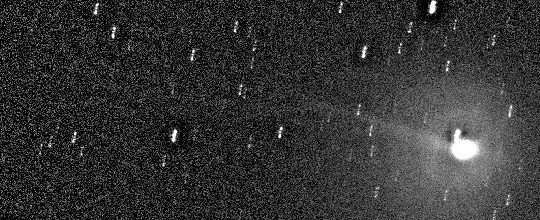
Now for the techie stuff:
Each original image was obtained using a Celestron C8 SCT at f3.3 with a MX916 CCD camera. The exposure was 20 seconds and an interval of 60 seconds between shots. The relatively short exposure was designed to give an unsaturated nucleus so that some photometry might be done on it. All of the images were dark frame subtracted and flat fielded prior to processing. Each of the frames is a group of 5 original images converted into and AVI file and then seriously processed in Registax. The resulting images were then save as JPEGs so that they could be opened in Adobe Photo Shop to align each frame.
Other Images
Sun | Comets | Mercury | Venus | Atmospheric Optics | Meteors | Auroa and NLC | Moon | Minor Planets | Mars | Jupiter | Saturn | Uranus | Neptune | Messier | Caldwell | All Deep Sky | Conjunctions | Transits | Solar Eclipse | Lunar Eclipse | Wide Field |ISS & Space Junk | Exo-Planets
All images are copyright. Permission must be sought to from the image owner to the use of any of these images.

